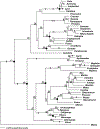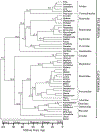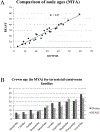Pattern and timing of diversification of the mammalian order Carnivora inferred from multiple nuclear gene sequences
- PMID: 20138220
- PMCID: PMC7034395
- DOI: 10.1016/j.ympev.2010.01.033
Pattern and timing of diversification of the mammalian order Carnivora inferred from multiple nuclear gene sequences
Abstract
The mammalian order Carnivora has attracted the attention of scientists of various disciplines for decades, leading to intense interest in defining its supra-familial relationships. In the last few years, major changes to the topological structure of the carnivoran tree have been proposed and supported by various molecular data sets, radically changing the traditional view of family composition in this order. Although a sequence of molecular studies have established a growing consensus with respect to most inter-familial relationships, no analysis so far has included all carnivoran lineages (both feliform and caniform) in an integrated data set, so as to determine comparative patterns of diversification. Moreover, no study conducted thus far has estimated divergence dates among all carnivoran families, which is an important requirement in the attempt to understand the patterns and tempo of diversification in this group. In this study, we have investigated the phylogenetic relationships among carnivoran families, and performed molecular dating analyses of the inferred nodes. We assembled a molecular supermatrix containing 14 genes (7765 bp), most of which have not been previously used in supra-familial carnivoran phylogenetics, for 50 different genera representing all carnivoran families. Analysis of this data set led to consistent and robust resolution of all supra-familial nodes in the carnivoran tree, and allowed the construction of a molecular timescale for the evolution of this mammalian order.
Copyright 2010 Elsevier Inc. All rights reserved.
Figures



Similar articles
-
Molecular phylogeny of the carnivora (mammalia): assessing the impact of increased sampling on resolving enigmatic relationships.Syst Biol. 2005 Apr;54(2):317-37. doi: 10.1080/10635150590923326. Syst Biol. 2005. PMID: 16012099
-
Phylogenetic relationships within mammalian order Carnivora indicated by sequences of two nuclear DNA genes.Mol Phylogenet Evol. 2004 Dec;33(3):694-705. doi: 10.1016/j.ympev.2004.08.001. Mol Phylogenet Evol. 2004. PMID: 15522797
-
Evolutionary history of Carnivora (Mammalia, Laurasiatheria) inferred from mitochondrial genomes.PLoS One. 2021 Feb 16;16(2):e0240770. doi: 10.1371/journal.pone.0240770. eCollection 2021. PLoS One. 2021. PMID: 33591975 Free PMC article.
-
Comparative chromosome painting in Carnivora and Pholidota.Cytogenet Genome Res. 2012;137(2-4):174-93. doi: 10.1159/000341389. Epub 2012 Aug 7. Cytogenet Genome Res. 2012. PMID: 22889959 Review.
-
The origin and diversification of eukaryotes: problems with molecular phylogenetics and molecular clock estimation.Philos Trans R Soc Lond B Biol Sci. 2006 Jun 29;361(1470):1039-54. doi: 10.1098/rstb.2006.1845. Philos Trans R Soc Lond B Biol Sci. 2006. PMID: 16754613 Free PMC article. Review.
Cited by
-
Evolutionary reconstructions of the transferrin receptor of Caniforms supports canine parvovirus being a re-emerged and not a novel pathogen in dogs.PLoS Pathog. 2012;8(5):e1002666. doi: 10.1371/journal.ppat.1002666. Epub 2012 May 3. PLoS Pathog. 2012. PMID: 22570610 Free PMC article.
-
Evolutionary conservation of Y Chromosome ampliconic gene families despite extensive structural variation.Genome Res. 2018 Dec;28(12):1841-1851. doi: 10.1101/gr.237586.118. Epub 2018 Oct 31. Genome Res. 2018. PMID: 30381290 Free PMC article.
-
Functional myology of the thoracic limb in Pampas fox (Lycalopex gymnocercus): a descriptive and comparative analysis.J Anat. 2018 Dec;233(6):783-806. doi: 10.1111/joa.12892. Epub 2018 Oct 14. J Anat. 2018. PMID: 30318591 Free PMC article.
-
Genome-wide signatures of complex introgression and adaptive evolution in the big cats.Sci Adv. 2017 Jul 19;3(7):e1700299. doi: 10.1126/sciadv.1700299. eCollection 2017 Jul. Sci Adv. 2017. PMID: 28776029 Free PMC article.
-
Phylogenomic datasets provide both precision and accuracy in estimating the timescale of placental mammal phylogeny.Proc Biol Sci. 2012 Sep 7;279(1742):3491-500. doi: 10.1098/rspb.2012.0683. Epub 2012 May 23. Proc Biol Sci. 2012. PMID: 22628470 Free PMC article.
References
-
- Agustí J, Antón M, 2002. Mammoths, sabertooths, and hominids: 65 million years of mammalian evolution in Europe. Columbia University Press, New York.
-
- Amrine-Madsen H, Koepfli K-P, Wayne RK, Springer MS, 2003. A new phylogenetic marker, apolipoprotein B, provides compelling evidence for eutherian relationships. Mol Phylogenet Evol 28, 225–240 - PubMed
-
- Arnason U, Gullberg A, Janke A, Kullberg M, 2007. Mitogenomic analyses of caniform relationships. Mol Phylogenet Evol 45, 863–874. - PubMed
-
- Arnason U, Gullberg A, Janke A, Kullberg M, Lehman N, Petrov EA, Vainola R, 2006. Pinniped phylogeny and a new hypothesis for their origin and dispersal. Mol Phylogenet Evol 41, 345–354. - PubMed
-
- Bininda-Emonds ORP, Gittleman JL, Purvis A, 1999. Building large trees by combining phylogenetic information: a complete phylogeny of the extant Carnivora (Mammalia). Biological Reviews of the Cambridge Philosophical Society 74, 143–175. - PubMed
MeSH terms
Grants and funding
LinkOut - more resources
Full Text Sources

